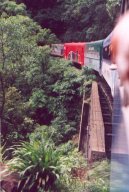| Introduction - Brazil: |
| Location - Brazil: |
| People - Brazil: |
| Government - Brazil: |
| Economy - Brazil: |
Economy overview | Characterized by large and well-developed agricultural, mining, manufacturing, and service sectors, Brazils economy outweighs that of all other South American countries and is expanding its presence in world markets. From 2001-03 real wages fell and Brazils economy grew, on average only 2.2% per year, as the country absorbed a series of domestic and international economic shocks. That Brazil absorbed these shocks without financial collapse is a tribute to the resiliency of the Brazilian economy and the economic program put in place by former President CARDOSO and strengthened by President LULA DA SILVA. Since 2004, Brazil has enjoyed continued growth that yielded increases in employment and real wages. The three pillars of the economic program are a floating exchange rate, an inflation-targeting regime, and tight fiscal policy, initially reinforced by a series of IMF programs. The currency depreciated sharply in 2001 and 2002, which contributed to a dramatic current account adjustment; from 2003 to 2006, Brazil ran record trade surpluses and recorded its first current account surpluses since 1992. Productivity gains - particularly in agriculture - also contributed to the surge in exports. While economic management has been good, there remain important economic vulnerabilities. The most significant are debt-related: the governments largely domestic debt increased steadily from 1994 to 2003 - straining government finances - before falling as a percentage of GDP beginning in 2003. Brazil improved its debt profile in 2006 by shifting its debt burden toward real denominated and domestically held instruments. LULA DA SILVA restated his commitment to fiscal responsibility by maintaining the countrys primary surplus during the 2006 election. Following his second inauguration, LULA DA SILVA announced a package of further economic reforms to reduce taxes and increase public investment. A major challenge will be to maintain sufficient growth to generate employment and reduce the government debt burden. |
|
Gdp purchasing power parity | $1.655 trillion (2006 est.) |
|
Gdp official exchange rate | $967 billion (2006 est.) |
|
Gdp real growth rate | 3.7% (2006 est.) |
|
Gdp per capita ppp | $8,800 (2006 est.) |
|
Gdp composition by sector | agriculture: 8%
industry: 38%
services: 54% (2006 est.) |
|
Labor force | 96.34 million (2006 est.) |
|
Labor force by occupation | agriculture: 20%
industry: 14%
services: 66% (2003 est.) |
|
Unemployment rate | 9.6% (2006 est.) |
|
Population below poverty line | 31% (2005) |
|
Household income or consumption by percentage share | lowest 10%: 0.7%
highest 10%: 31.27% (2002) |
|
Distribution of family income gini index | 56.7 (2005) |
|
Inflation rate consumer prices | 3% (2006 est.) |
|
Investment gross fixed | 20.2% of GDP (2006 est.) |
|
Budget | revenues: $244 billion
expenditures: $219.9 billion; including capital expenditures of $NA (FY07 est.) |
|
Public debt | 50% of GDP (2006 est.) |
|
Agriculture products | coffee, soybeans, wheat, rice, corn, sugarcane, cocoa, citrus; beef |
|
Industries | textiles, shoes, chemicals, cement, lumber, iron ore, tin, steel, aircraft, motor vehicles and parts, other machinery and equipment |
|
Industrial production growth rate | 3.2% (2006 est.) |
|
Electricity production | 546 billion kWh (2005) |
|
Electricity consumption | 415.9 billion kWh (2005) |
|
Electricity exports | 7 million kWh (2004) |
|
Electricity imports | 39 billion kWh; note - supplied by Paraguay (2005) |
|
Oil production | 1.59 million bbl/day (2006 est.) |
|
Oil consumption | 2.1 million bbl/day (2006 est.) |
|
Oil exports | 278,400 bbl/day (2005) |
|
Oil imports | 674,500 bbl/day (2004) |
|
Oil proved reserves | 12.22 billion bbl (2006 est.) |
|
Natural gas production | 9.66 billion cu m (2004 est.) |
|
Natural gas consumption | 17.28 billion cu m (2004 est.) |
|
Natural gas exports | 0 cu m (2004 est.) |
|
Natural gas imports | 8.07 billion cu m (2006 est.) |
|
Natural gas proved reserves | 306 billion cu m (2005 est.) |
|
Current account balance | $13.5 billion (2006 est.) |
|
Exports | $137.5 billion f.o.b. (2006 est.) |
|
Exports commodities | transport equipment, iron ore, soybeans, footwear, coffee, autos |
|
Exports partners | US 17.9%, Argentina 8.6%, China 8.2%, Germany 4.1% (2006) |
|
Imports | $91.4 billion f.o.b. (2006 est.) |
|
Imports commodities | machinery, electrical and transport equipment, chemical products, oil, automotive parts, electronics |
|
Imports partners | US 20.4%, Argentina 8.2%, China 7.8%, Germany 7.5% (2006) |
|
Reserves of foreign exchange and gold | $87.27 billion (January 2007 est.) |
|
Debt external | $176.5 billion (30 November 2006 est.) |
|
Economic aid recipient | $30 billion (2002) |
|
Currency code | real (BRL) |
|
Exchange rates | reals per US dollar - 2.1761 (2006), 2.4344 (2005), 2.9251 (2004), 3.0771 (2003), 2.9208 (2002) |
|
| Communications - Brazil: |
| Transportation - Brazil: |
| Military - Brazil: |
This page was last updated on 16 September, 2007



